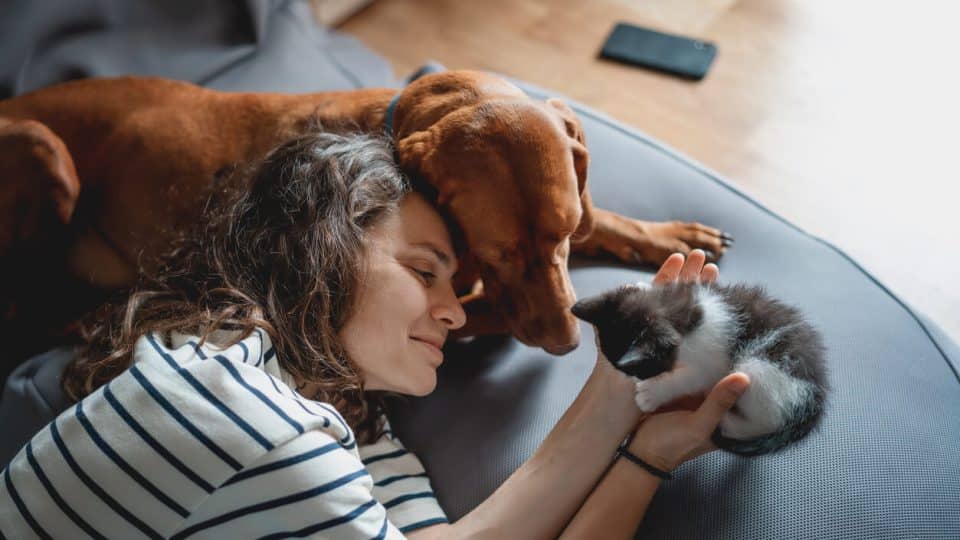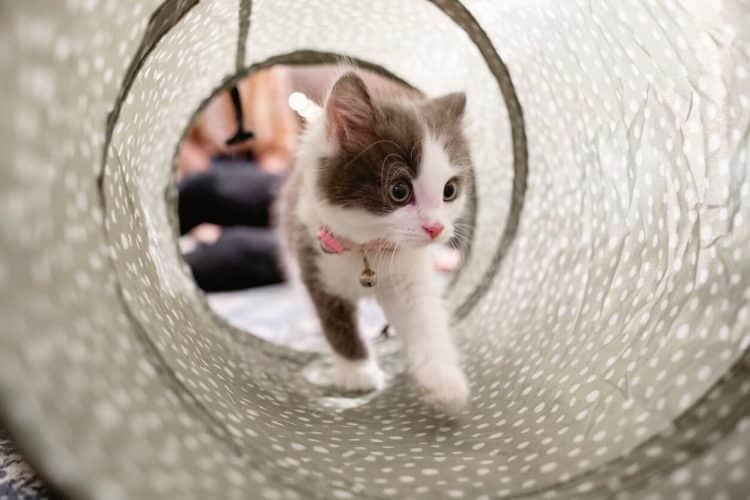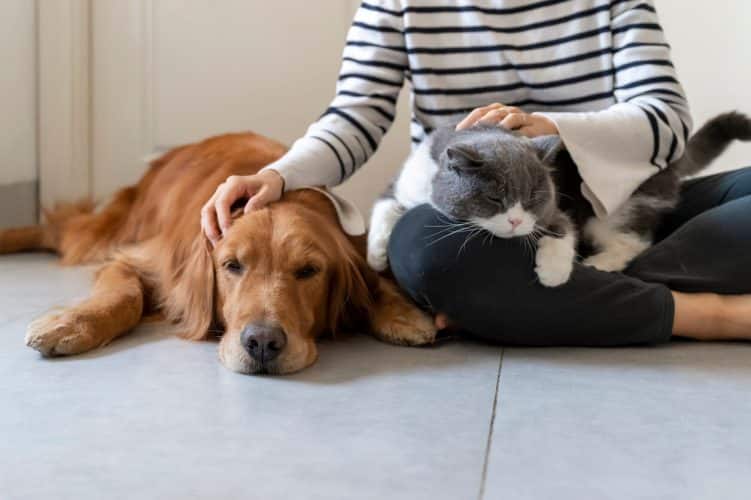After you gather the essential kitten supplies and bring your new kitten home, what comes next? According to feline experts, it’s essential to learn how to socialise a kitten the right way—with plenty of hands-on interaction.
“Socialising is the process of teaching a kitten how to appropriately interact with other cats, humans, or other species,” explains Joey Lusvardi, certified cat behaviour consultant and owner of Class Act Cats. In a nutshell, socialisation sets kittens up to be friendly and adaptable. It can also help reduce unwanted behaviours, like fighting.
So, as you brush up on your new kitten’s dietary needs and behavioural quirks and consider the perfect kitten names, you’ll also want to spend lots of time cuddling, playing with, rewarding, and swooning over your new fur ball. Below, learn everything you need to know about socialising kittens.
What’s The Ideal Time Frame For Socialising Your Kitten?
Socialisation is a crucial step in a kitten’s development. Ideally, this process begins before kittens leave their mum, or between two and seven weeks old.
Kittens are most impressionable during this sensitive period, explains Samantha Bell, cat expert at Best Friends Animal Society. Kittens who don’t get enough human handling before seven weeks old may have trouble trusting humans later in life, she says.
Before kittens go to their forever homes (which shouldn’t happen until they reach at least eight weeks), they learn socialisation skills from their mother, littermates, foster pet parents, animal shelter staff, or breeder caretakers.
Examples of socialisation include:
- getting used to (and enjoying!) human touch
- meeting new people
- playing with new toys and objects
- hearing new sounds
- exploring new surroundings
- interacting with littermates
What if you adopt an older kitten?
It’s never too late to socialise a kitten!
“It’s still possible for a cat to learn how to interact with and be comfortable around individuals past the socialisation period of kittenhood,” Lusvardi says.
Socialising an older kitten or adult cat will usually just take more time and patience. Keep in mind, too, that the goal of socialisation isn’t necessarily for your cat to get along with every other person or animal. If your cat will stay indoors with one other resident cat, you really only need to worry about socialising them with that specific cat and any humans they’ll encounter on a regular basis.
Once you bring your kitten or cat home, introduce them to other pets and people as soon as it’s safe to do so.
It’s always helpful to ask the shelter or your cat’s first family for detailed information about their early life history, including how long they stayed with their mother and whether they’ve lived with other pets before. This can give you a better idea of how socialised your cat already is.
Why Is Socialisation Important For Kittens?
Socialised cats are more likely to feel confident in their environment and less likely to show stress or anxiety-related behaviour concerns later in life, Lusvardi says.
Cats and kittens who don’t get socialised:
- Often show fear and distress around unfamiliar people, animals, and situations
- May find it tough to adjust to new situations and environments, like a new home or the vet’s office
- Have a higher chance of developing behavioural problems, from scratching furniture to avoiding the litter box
- May be more likely to attack humans and other pets
By exposing kittens to new sights, sounds, people, and animals in a positive way, you’re maximising their chances of growing up as confident—and happy—adult cats.
4 Steps To Socialising Your Kitten
Lusvardi says to think of socialisation steps in terms of senses. While there’s some flexibility, he finds the following order easiest—and most widely accepted by cats and kittens.
- Scent. Let your kitten smell new people, animals, and objects by introducing clothing, blankets, or toys belonging to other people and animals. Discover what scents they like or dislike by introducing stimulating scents such as catnip, basil, and non-toxic flowers.
- Sound. You can use recordings to get kittens used to everyday noises that might create stress, like crying, street noise, or barking. Start by keeping your cat at a distance from the source of the sound. Then, gradually shorten the distance to increase the volume over time.
- Sight. Before you allow any face-to-face meetings, introduce your kitten to new people or animals one at a time from a safe distance. They may want to observe from inside their favourite cardboard box, on a high-up perch, or behind a secure gate.
- Touch. After positive associations experiencing all other senses, your cat or kitten can meet new people and pets face-to-face.
“During these interactions, the kitten should be getting treats, playing, and generally having a good time so they are more likely to enjoy these interactions,” Lusvardi says. “Reward positive interactions and gently end the interaction if the kitten is not having a good time.”
Important! It’s always best to take things slow. Skipping ahead or moving too quickly could cause a long-lasting fear of an experience, object, or pet.
You can make socialisation even more fun by creating an experience checklist and ticking off activities as you and your cat complete them. This reduces the chance of forgetting a critical step in your kitten’s development, Lusvardi says. He recommends Fear Free Pet’s Socialisation Bingo as his personal favourite.
Useful Items For Socialising A Kitten
Helpful socialisation tools include:
- Treats, food, or other rewards your kitten loves. Practice positive reinforcement by giving rewards to your cat when they experience something new. When you want to keep cats distracted, you can also place treats and food on lick mats.
- Toys your cat enjoys. Having a few options helps create a positive experience. Wand toys in particular are great for reducing tension between cats, Lusvardi says.
- A baby gate or screen. Use these to control your kitten’s interactions with other people or animals, ensuring gradual and positive interactions. A large playpen may also come in handy.
- Towels, carriers, nail clippers, brushes, toothbrushes, and other supplies. Choose any items you want your kitten to get comfortable with. Successful socialisation helps prevent negative associations with these items.
Consider adapting your space to fit your cat’s needs before bringing them home by setting up:
- boxes for hiding
- a room or private space
- cosy bedding
- scratching posts
- toys
When in doubt, ask a veterinarian about creating a stress-free environment based on your cat’s needs and age. For instance, some rescue cats may benefit from calming pheromones.
How To Socialise A Kitten With People
The amount of time it takes for a kitten to get comfortable around people generally depends on the cat. It could take days or weeks. Rewarding cats often will help them associate humans with positive experiences and make the process easier for you both!
Once your kitten or cat is comfortable with physical touch, you can start gradually picking them up.
Other helpful tips:
- Smell. Provide your kitten with a clothing item of the person you’d like to introduce, like a baby blanket or t-shirt.
- Sound. When introducing cats to kids, consider playing a recording of your baby crying or toddler laughing first. Then, when entering the room, use a soft, soothing voice to announce your presence—and encourage kids to do the same.
- Sight. Staying at a distance, let the cat or kitten make the first move. Extend your hand, encouraging them to smell an extended finger.
- Touch. Only pet a cat or kitten when they approach first. “Allowing them to initiate contact can help them feel safer, according to Lusvardi. He adds that the best places for initial contact are a cat’s cheeks or chin. When they feel more comfortable, you can move on to more sensitive areas like their back, shoulders, and sides.
How to get kittens used to the vet
Consider asking your vet if they offer victory visits. This type of vet visit gives your cat or kitten the opportunity to sniff the exam room, eat treats, play, meet the veterinarian and vet techs, and just have a good time.
“Believe it or not, it’s possible for cats to not dread the vet if done correctly,” Lusvardi says. “And a victory visit is one way to help set the kitten up for lifelong success!”
How To Socialise A Kitten With Other Cats
Young kittens aren’t fully vaccinated until they’re about 16 weeks old. So, if other household cats aren’t fully vaccinated, you’ll want to wait to let them meet until your kitten has had all their shots.
Once everyone can safely meet and greet, Lusvardi suggests slowly introducing pets one at a time. Keep in mind that older cats may not find a bubbly kitten endearing—at least at first.
Scent
“Start by swapping scents using bedding or other materials that are soaked in the scent of each cat,” Lusvardi says.
Once they’re comfortable being around each other’s scent, swap territories. Let your kitten explore your cat’s favourite space while the cat explores the kitten’s secure room.
“It’s not a good idea to bring either cat into a space in a carrier and allow the other one to sniff them, nor is it a good idea to have both cats confined in carriers,” Lusvardi says.
Sight
The cats can visually meet with a gate or barrier between them. Lusvardi recommends keeping the kitten in a large playpen in their territory. The playpen should include a box or other cubby for the kitten to retreat to if needed.
“Both the kitten and the older cat should get attention, play, and praise for positive interactions,” he says. If the older cat hisses or displays aggressive behaviours, he recommends ending the interaction and separating them completely.
The next time they meet, keep the interaction short and gradually process to longer interactions.
Touch
Avoid letting cats meet face-to-face until they’ve had several positive interactions. Even then, keep meetings brief and supervised, Lusvardi says. It’s also wise to keep a blanket or sheet of cardboard nearby in case of aggression.
Gradually increase the length of time they interact—but continue to supervise their interactions until both cats clearly show they’re OK in each other’s company.
Note: kittens adopted in pairs may have a paw up on socialisation. A playmate allows them to continue learning how to hunt, wrestle, and play. Plus, you’ll have the joy of watching two kittens grow up together.
How To Handle Meals During Kitten Socialisation
You may have come across the tip that feeding cats near each other can help them bond.
In reality, eating meals near one another is unnatural for cats, and cats who eat near one another may experience mealtime stress, Lusvardi says.
“It can be deceptive to rely on the cats eating near each other as a sign of acceptance,” he says. “The cat may be hungry enough to put up with a cat they don’t like!”
He recommends feeding cats separately after an interaction to create a positive association between the other cat and a coming meal.
Another mealtime perk: Feeding cats on a dedicated schedule builds trust. It’s one reason the International Association of Animal Behavior Consultants recommends against free feeding.
How To Handle Playtime During Kitten Socialisation
Ensure everyone plays nice by paying close attention to body language.
If you suspect a cat fight is brewing, end the interaction before things escalate. Stopping a fight before it happens can prevent a rift in their relationship that can be challenging to repair.
Never force cats to interact with each other, Lusvardi emphasises. You can also keep interactions friendly by participating in play and rewarding both cats with treats and praise.
Why Positive Reinforcement Is The Best Approach
Behaviours like hissing, swatting, or biting communicate feelings of fear, stress, or danger. Punishing, or disciplining a cat, for these natural behaviours isn’t just ineffective. It can also do a lot of harm to your relationship.
Instead, be patient and work to figure out what’s causing the behaviour, Bell says.
It’s also important to reward your cat for any behaviours you want to see more of, including:
- interacting with objects
- hearing new sounds
- meeting other animals
- coming to you for petting
Giving your cat something they love, like attention, a toy, or a treat, can help strengthen your bond and increase the chance your cat will do these things more often.






